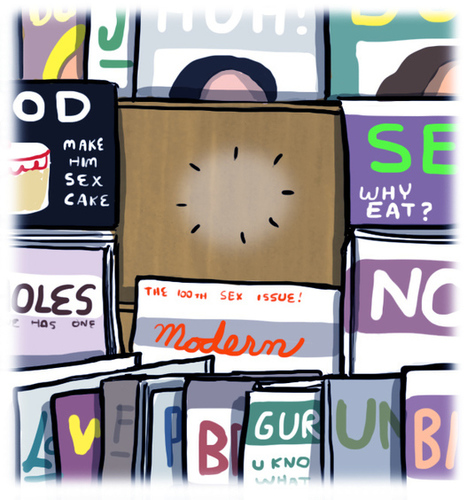 Your new post is loading...
 Your new post is loading...
The smartphone promises a new golden age of journalism.
...Journalism, however, is holding its own. Statistics from the Times say roughly half of the people who read it now do so with their mobile devices, and that jibes with figures from the latest Pew report on the news media broadly. But if you were to assume that means people have given up reading actual articles and are just snacking instead, you'd be wrong.
The Atlantic recently reported that a gorgeously illustrated 6,200-word story on BuzzFeed—which likewise gets about half its readers through mobile devices—not only received more than a million views, it held the attention of smartphone users for an average of more than 25 minutes. (WIRED's in-depth web offerings have also attracted audiences. A profile of a brilliant Mexican schoolgirl garnered 1.2 million views, 25 percent of them from phones, and readers spent an average of 18 minutes on it.)
Little wonder that for every fledgling enterprise like Circa, which generates slick digests of other people's journalism on the theory that that's what mobile readers want, you have formerly short-attention-span sites like BuzzFeed and Politico retooling themselves to offer serious, in-depth reporting. “Maybe we're entering into a new golden age of journalism,” venture capitalist Marc Andreessen mused in a recent blog post, “and we just haven't recognized it yet.”...
In a year with more tools at digital journalists’ disposal than ever before, it can be hard to pick what’s really worth using. At NewsWhip, we’re constantly thinking about how online journalists can do their jobs better. That means we come across some of these tools pretty regularly – we even use some of them ourselves. Earlier today, the good folk over at journalism.co.uk listed the 10 key skills that digital journalists need to hone this year. It’s a list that illustrates the changing skillset of the modern online journalist.
On foot of that, here’s our list of top tools for helping today’s digital newsroom put those skills into action. They’re all very simple to use and capable of making a fast impact on your workflow or content. Just click on the titles for a direct link to the tool....
David Carr’s weekly column for The New York Times carries an intriguing title: “The Media Equation.” With 430,000 Twitter followers, he’s a unique journalist exploring the world of media for the larger Times brand, with its 9.5 million followers. It’s similar to the 1,200 individually branded FORBES contributors — and staff reporters, too — who now write about specific business topics under our 96-year-old umbrella brand.
I love the rubric attached to David’s newspaper work. FORBES itself is trying to figure out the media equation in an era when anyone can publish anytime — no trucks, planes or satellites required. Our still-evolving solution disrupts century-old newsroom thinking and processes. It also breaks with tradition in how certain marketing messages are sold and integrated on our growing news platform....
Five Steps to Multimedia Storytelling Is a valuable, free course offered through Poynter News University.
TITLE:Five Steps to Multimedia StorytellingTYPE:Self-Directed Course T IME ESTIMATE:This course takes about one to two hours to complete.
ABOUT SELF-DIRECTED COURSES
In a self-directed course, you can start and stop whenever you like, progressing entirely at your own pace and going back as many times as you want to review the material.
Want to spread your wings beyond print reporting, but don’t know where to start? In this course, you’ll learn the basic steps of telling your story with multimedia. You’ll discover ways to map out your story before you head out to do your reporting. And you’ll learn when to use such tools as audio, video and graphics.
WHAT WILL I LEARN? - Upon completing this course, you will be able to:Identify the elements in a multimedia story. - Understand which stories are more suitable for multimedia - Sketch a concept for a story - Identify tools needed to gather content in the field...
Allow me a moment of nostalgia for the classic liveblog. “Liveblogging” was this thing we used to do before the rise of Twitter and Storify, much like good old-fashioned blogging itself. You’d have a host and a bunch of guests all watching the same Web page together, and for an hour or so, they’d make magic.
I should confess: every now and then, I get a hankering for some of that old magic. I pour some good wine, dust off a CoverItLive console, and invite some friends over.* And every time I do, I’m reminded why genuine liveblogging — real-time, browser-based liveblogging — is still one of my favorite instruments in the modern journalism toolkit. I highly recommend it to you, for reasons I outline below. And I’ll also give you some pointers on how to do it....
Create Epic Stories with Shorthand...
New storytelling tool for journalists, writers and creative people looks very promising. It's in beta and is definitely worth exploring.
Coca-Cola have made the transition to brand journalism, using its corporate site as a digital magazine... Journalism is currently going through a transition. As this transition takes place, advertising revenue has dropped off, PR has gone up and ‘churnalism’ has become a worrying issue of newsrooms. But why would corporations go through all the hassle of press releases or creating stories for their products when they could just do it themselves? After all, according to Harry Evans, news is “something someone somewhere doesn’t want you to hear”. Three days ago, Coca-Cola took the first step into the world of brand journalism. It has completely overhauled its corporate site, rebranded and repackaged it as a digital magazine, Coca-Cola Journey. This will allow it to produce ‘news’ to its own agenda. Ashley Brown, director of digital communications and social media at Coca-Cola, said: “Our corporate site is our most trafficked online property, so we wanted to create an experience that would make this incredibly valuable digital real estate work harder for us. “We want to make sure that as our brand becomes a publisher, we do so in the most beautiful and functional way possible.”... [Journalism? Meet brand journalism.]
This week, the Marketeer rolls out a new list in the vein of our “50 brands and marketers to watch” campaigns. Each day, we’ll debut five interviews from our list of 25 Journalists in Content Marketing before releasing the entire package as one slideshow on Monday, September 17.
Today’s group includes Sympoz Inc.’s Lisa Greim, Paul Conley of Paul Conley Consulting, Monetate’s Rob Yoegel, Kuno Creative’s Brianne Carlon, and Kevin Hunt of General Mills.
Click through to read their responses to our questions about the roles they play in their organizations’ content marketing efforts; their information diets; the content they’re most proud of creating; their favorite tech and software tools; where they find inspiration for content; and their advice on content marketing....
Comparing a traditional news story about a recent shooting with a news report from a Reddit user -- who pulled together Twitter messages from the perpetrators and victims -- provides a glimpse of what a real-time, crowdsourced newsroom of the... ...Mark Little of Storyful, which works with mainstream media outlets to do exactly that kind of thing, has written about how journalists need to stop seeing themselves as gatekeepers of information and start to look at journalism as a collaborative effort involving all kinds of different sources. Twitter is clearly one of these sources, as the Toronto shooting shows — and so is Reddit, which has already proven in the past that it can be a crowdsourced fact-checking engine. And those who learn how to make use of all these tools will wind up producing better journalism.... [Very thought-provoking and worth reading - JD]
The Reynolds Journalism Institute just released part 2 of its 10-part series on mobile. This second installment included an interesting section on news consumption through mobile devices.
…two-thirds (67%) of mobile media owners ages 18-34 used their devices to access local, national and international news provided by news organizations for an average of five hours per week....
[The prizes go to the PR, content marketing and media nimble - JD]
In a discussion about his use of Twitter as a reporting tool, NPR strategist Andy Carvin made some interesting points about the value of crowdsourced journalism -- including the importance of being transparent about the process, and the virtues of being human....
|
...There’s nothing wrong with the classic tools; they just aren’t the latest ones. So I turned to Ben Wirz, who a couple of digital lifetimes ago joined Knight as director of business consulting. Ben helps lead the Knight Enterprise Fund, which invests in startup companies.
Here are his notes on tools journalists and news organizations should try....
Today it was revealed that Vox Media, owner of The Verge, SB Nation, and Polygon has raised another $40 million of funding.
...But bigger exits are emerging: There was Huffington Post and Bleacher Report. There’s that Vice valuation. And even Swisher and Mossberg without a site are rumored to be in the $30 million valuation size — bigger than what TechCrunch sold for after six years. A pattern is forming.
The investments in Buzzfeed and Vox in particular show that well-heeled investors believe that new media can be more than just profitable lifestyle businesses buoyed by non-scalable event franchises. These guys are betting there are big public companies here.We’re seeing the same kind of transition with content that we saw with the early Web 2.0 companies like Delicious and Flickr. They sold out cheap at first as projects morphed into companies and then the next generation thought bigger....
The five W’s of journalism remain a cornerstone of newsgathering today, but I have been increasingly thinking about five C’s as well: Context, Conversation, Curation, Community and Collaboration.
Below I try to define each, with particular attention to how they intersect, and I link to one good piece of writing on the topic. Nothing about this is supposed to be comprehensive, nor is it particularly original, it’s just a list of the things I’m thinking about right now and an invitation for you to add your thoughts...
"Hi is a website that lets you attach a snippet of text and a photograph to a location. We call that a moment. Moments are grouped by location. You can then choose to return to that moment later and extend it — write 100 or 10,000 words about it. That collection — moments tied to location, some short, some extended — is a narrative mapping."
Via Marie-Sophie
...You’re off to a great start. However, you’ve only started to scratch the surface of the content possibilities because your audience reach is still limited — while your corner of the world is engaged, you aren’t quite at the center of the wider industry conversation yet. If we agree that the goal of content marketing should be to enable your content creators to function as brand journalists (we do, right?), then it’s fair to equate your content effort to that of a weekly community paper. However, there’s an even bigger opportunity here, because online content can help you extend your reach far beyond your current community and create an exponential opportunity for your business....
You'll never believe Peter Koechley's OUTRAGEOUS headline writing tips. For most of us in the online journalism business, writing headlines basically amounts to guesswork. Will people click on this? Are there enough nouns in here for Google to find it? Does this line break look weird? Should I use a question mark? An exclamation point? For Upworthy, it’s more akin to a science — and not one of those mushy sciences like anthropology or psychology, either. We’re talking straight-up particle physics. For every article they publish, its writers come up with 25 headline options. They then A/B test the four most promising before settling on a winner. The result: In just 11 months, with a smallish staff and not much original content, Upworthy has built a sizable audience (8.7 million monthly unique visitors as of last November) for its socially progressive message, plus a Facebook following of more than 1 million fans....
In print, decades of design language have helped publications draw extra attention of readers. But news web design has mostly been straitjacketed in rigid templates. A few news sites are trying to break out. When it comes to reading long form, the web can be an ugly, distracting place. It’s the reason why services like Instapaper and Pocket (née Read It Later) exist: to strip content of its context — noisy site designs, advertisements, and other unnecessary elements. But perhaps we’re moving into a new era where more of the web is clean and readable. Maybe the future of web publications will be beautiful enough that the reading experience is more enjoyable in its natural habitat. This is how I felt, at least, when I came across ESPN.com’s “The Long Strange Trip of Dock Ellis,” a gorgeously designed feature about the Pittsburgh Pirates pitcher who threw a no-hitter while under the influence of LSD. It’s arguably one of baseball’s most colorful tales; this take on it is certainly one of the most ambitious web designs ever attempted by a traditional media company for a single article. The piece is generously adorned with accompanying visuals — photos of Ellis, memorabilia like trading cards, pull quotes, all moving and sliding while the reader scrolls. The reading experience is very comfortable on both desktop and tablet, thanks to a larger text size and generous amounts of white space. It’s feels like an experience instead of a block of words surrounded by the detritus of the web.... [This ESPN story is a fascinating design innovation for a news organization. ~ Jeff]
In a bold first-day speech, the BBC's new boss says the corporation must stop thinking that online innovation means repurposing broadcast content and instead 'create genuinely digital content for the first time'. ...“Yet it’s the quest for this – genuinely new forms of digital content – that represents the next profound moment of change we need to prepare for if we’re to deserve a new charter. “As we increasingly make use of a distribution model – the internet – principally characterised by its return path, its capacity for interaction, its hunger for more and more information about the habits and preferences of individual users, then we need to be ready to create content which exploits this new environment – content which shifts the height of our ambition from live output to living output. “We need to be ready to produce and create genuinely digital content for the first time. And we need to understand better what it will mean to assemble, edit and present such content in a digital setting where social recommendation and other forms of curation will play a much more influential role.... [The new leader points to fresh news directions ahead for the BBC. His remarks are relevant to content producers, marketing and PR too. - JD]
This week, a guest essay from my colleague Patrick LaForge on a perennial problem - leads (and other sentences) that tax readers' patience:... No one sets out to write an opening sentence so long that it frustrates and irritates readers. But that’s what we sometimes do. Writers are not always the culprits. Too often, editors are the ones overstuffing leads with background, context and tangential explanations. It’s a collective effort. We need to do better. ••• Two recent examples weighed in at 55 words each and actually prompted reader complaints...
Apps and visual content make better use of the Internet's capabilities, so not surprisingly content creators must begin to expand expertise. For a window into the future of content, look no further than the industry that creates more content than any other — journalism. The emerging opportunities in journalism lie in programming, not writing, as can be seen from the number of job postings. User demand is for apps, in addition to stories, videos, infographics and slideshows. Who are these journo-programmers, and what can they tell us about staying relevant in the content industry?...
A reporter walks into a marketing agency and a “branded journalist” is born. What once seemed like the set-up to a joke is just a reality of the new media age, explains content marketer Biserka Anderson. ...Flash forward to the present. Content marketing is the buzzword of the year and empowered businesses are pumping out editorial content in a race to spread their messages and reach an increasingly active community of online users. For many traditional newsrooms, meanwhile, digitization appears to have spelled little more than doom and gloom – squeezed advertising margins, dwindling circulations, editorial layoffs....
|



 Your new post is loading...
Your new post is loading...





























Here's a good read and some interesting reflections on mobile phones and the past and future for journalism .